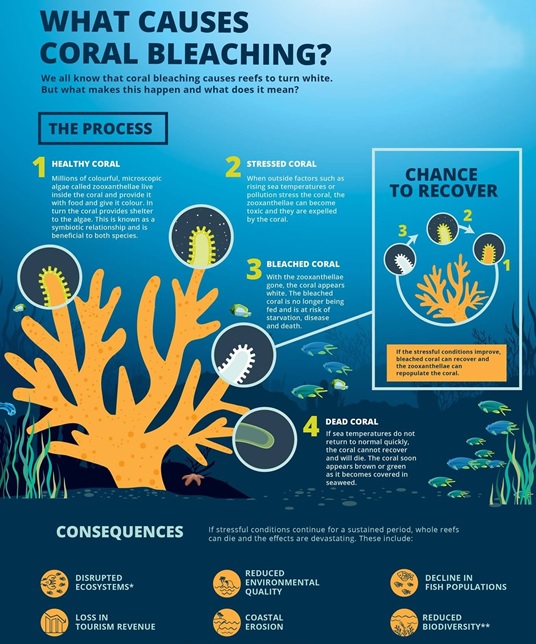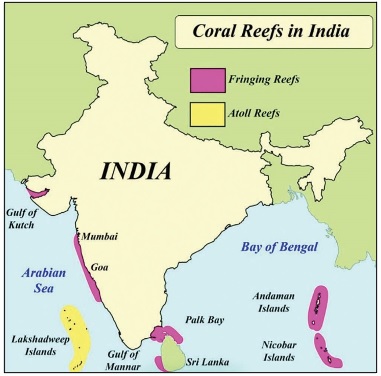Corals are crucial marine invertebrates that form coral reefs through colonies of calcium carbonate-secreting polyps. They rely on symbiotic algae called zooxanthellae for nutrition. In recent years, climate change has significantly increased coral bleaching events, severely impacting global marine biodiversity.
What is Coral Bleaching?
- Coral Bleaching is an environmental phenomenon in which corals lose their color, appearing white or pale yellow.
- The primary cause is the loss or death of their symbiotic algae, zooxanthellae, which provide corals with both color and energy through photosynthesis.
- When the algae are expelled, corals lose their color and struggle to survive.

Natural Habitat of Corals
- Latitude: Between 30°N and 30°S
- Water: Clear, shallow, and sunlight-rich
- Temperature: 16–32°C
- Depth: Less than 50 meters
Global Distribution
- Major Coral Reefs: Australia, Indonesia, Philippines
- Coral Triangle: The richest marine biodiversity area in the world
- Members: Indonesia, Malaysia, Philippines, Papua New Guinea, Timor-Leste, Solomon Islands
Importance of Coral Reefs
- Biodiversity Hotspots
- Provide habitat and food for ~25% of all marine species.
- Coastal Protection
- Act as natural breakwaters, protecting coastlines from storms, erosion, and flooding.
- Economic Value
- Through tourism, fisheries, and coastal protection, coral reefs contribute approximately $10 trillion annually to the global economy.
Major Threats to Coral Reefs
-
Coral Bleaching
- Occurs due to thermal stress, light imbalance, and nutrient deficiencies, causing corals to expel their symbiotic algae.
- 2024 marked the 4th Global Coral Bleaching Event (GCBE-4):
- Over 77 coral reefs worldwide affected.
- In India, affected areas include:
- Andaman & Nicobar Islands
- Lakshadweep
- Gulf of Mannar
- Gulf of Kutch

-
Other Threats
- Global warming
- Coral mining for construction
- Aquarium trade
- Overfishing
- Ocean acidification
- Coastal pollution and sedimentation
- Offshore construction and shipping
Coral Conservation Efforts
(A) Efforts in India
- Wildlife (Protection) Act, 1972
- Corals listed under Schedule I (highest protection).
- National Committee for Mangroves, Wetlands, and Coral Reefs, 1986
- Coordinates national-level conservation strategies.
- Environment (Protection) Act, 1986
- Prohibits use of coral and sand for construction.
- Local Restoration Projects
- Gulf of Kutch: Biorock technology
- Tamil Nadu: Artificial reefs
(B) Global Efforts
- ICRI (International Coral Reef Initiative)
- International collaboration for coral conservation; India is a member.
- CITES
- Coral species listed in Appendix II to regulate trade.
- UNESCO World Heritage Sites
- Recognizes significant coral reefs as world heritage sites.
Way Forward
- Local-level Conservation
- Reduce nutrient-rich runoff from rainwater
- Control coastal pollution, plastic, and sedimentation
- Implement sustainable fishing practices and enforce Coastal Regulation Zones (CRZ)
- Combating Climate Change
- Limit global temperature rise
- Reduce greenhouse gas emissions
- Transition to renewable energy sources
- Scientific Measures
- Cryopreservation: e.g., Taronga Cryodiversity Bank for coral gametes
- Engineering Solutions: Biorock technology, artificial reefs
- Promote resilient coral species
- Community-Based Management
- Involve coastal communities
- Encourage sustainable tourism
- Establish local conservation committees
Conclusion
Coral reefs are among the most productive and sensitive ecosystems on Earth. Increasing global warming and ocean acidification have accelerated coral bleaching, threatening marine biodiversity, coastal communities, and the global economy. Only strong policy interventions, climate action, scientific techniques, and community-based conservation can ensure the survival of corals.




